Physical Address
304 North Cardinal St.
Dorchester Center, MA 02124
This chapter provides an overview of the surgical treatment for lung cancer. The indications for surgery, types and extent of lung resection, and mediastinal lymphadenectomy are reviewed, with an emphasis on recent published evidence and the new international tumor-node-metastasis (TNM) staging system (seventh edition, 2009). Minimally invasive lung resection (see Chapter 18 ), tracheal lesions (see Chapter 8 ), tumor invading the chest wall (see Chapter 20 ), and multimodality approaches (see Chapter 19 ) are specifically covered separately.
Lung cancer remains the leading cause of cancer death worldwide, with an estimated 159,480 deaths and 228,190 new cases in the United States in 2013. Complete surgical resection is the treatment of choice for patients with early-stage (stages I and II) and selected locally advanced (stage III) non–small cell lung cancer (NSCLC). Surgery may have a role to play in the following cases as well: NSCLC with isolated adrenal metastasis, isolated brain metastasis, or highly selected small cell lung cancer. Adjuvant chemotherapy has been established as a modality to improve survival in selected resectable NSCLC on the basis of published clinical studies including phase III randomized trials. Neoadjuvant therapy (induction chemotherapy or chemoradiotherapy) improves outcome in patients with N2 disease or resectable, locally advanced NSCLC.
The first lobectomy for lung cancer was described by Davies in 1913-1914; the patient died 8 days after resection, with empyema. As water-sealed drainage system and anesthetic techniques advanced, surgical resection for lung cancer became prevalent. In 1933, Graham and Singer reported the first successful one-stage pneumonectomy. Since then, the standard operation for lung cancer became pneumonectomy with the technique of individual hilar ligation of the pulmonary vessels and suturing of the bronchus. Around the same time, Churchill and coworkers described their experience of lobectomies with hilar dissections. The technique of segmentectomy for lung cancer was described by Overholt and Langer. As refinements progressed, more advanced techniques were developed, including sleeve resection by Price-Thomas in 1956, carinal resection by Mathey and colleagues and Thompson, and Pancoast tumor resection by Chardak and MacCallum. Grillo and colleagues reported on carinal resection with airway reconstruction in 1963. In 1973, Jensik and colleagues reported a large series of segmental resections as intentional curative procedures for the treatment of bronchogenic carcinoma. Since the early 1990s, as the system of video endoscopy and endoscopic instruments have evolved, video-assisted thoracoscopic surgery (VATS) for major pulmonary resection has continued to develop worldwide. More recently, studies have demonstrated that robot-assisted surgery is a safe and feasible operation for pulmonary resection.
Lobectomy with complete en bloc tumor removal remains the standard surgical procedure in patients with resectable NSCLC. Resections less extensive than lobectomy (i.e., segmentectomy and wedge resection) are chosen in patients with limited pulmonary reserve or, recently, in those with small peripheral tumors without nodal disease for curative intent. The indications for curative-intent sublobar resection are discussed later. On occasion, sleeve lobectomy is required when the tumor protrudes into the mainstem bronchus. A concern with sleeve lobectomy is that it might be an inferior oncologic resection compared with pneumonectomy; however, sleeve lobectomy, compared with pneumonectomy, has demonstrated better long-term outcome, that is, lower morbidity and mortality rates.
The patient is placed into the lateral decubitus position. Entry into the pleural space via a posterolateral incision is the standard that provides an excellent exposure to the hilum of the lung. The anterior serratus muscle can be mobilized and spared whenever possible. The intercostal muscle, in most cases the fifth intercostal, is cut along the rib both anteriorly and posteriorly to obtain wider rib spreading. Anterior, lateral, or axillary thoracotomies are other alternatives. Occasionally, a hemi-clamshell incision or median sternotomy is selected for extended resection of apical tumors because either provides excellent exposure of the thoracic inlet, superior pulmonary veins, and main pulmonary arteries.
After the pleural cavity is entered, careful inspection of the pleural space is performed. Any pleural fluid is sampled for cytology and culture. All lobes of the lung are then palpated to assess the extent of the disease, to identify unexpected pleural or parenchymal lesions, and to confirm resectability. The inferior pulmonary ligament is incised up to the inferior pulmonary vein, and the mediastinal pleura of the hilum is incised circumferentially to totally mobilize the lung. Care must be taken to prevent injury to the phrenic nerve by electrocautery when the anterior hilum is opened. The posterior views of right and left pulmonary hila are shown in Figure 17-1 .
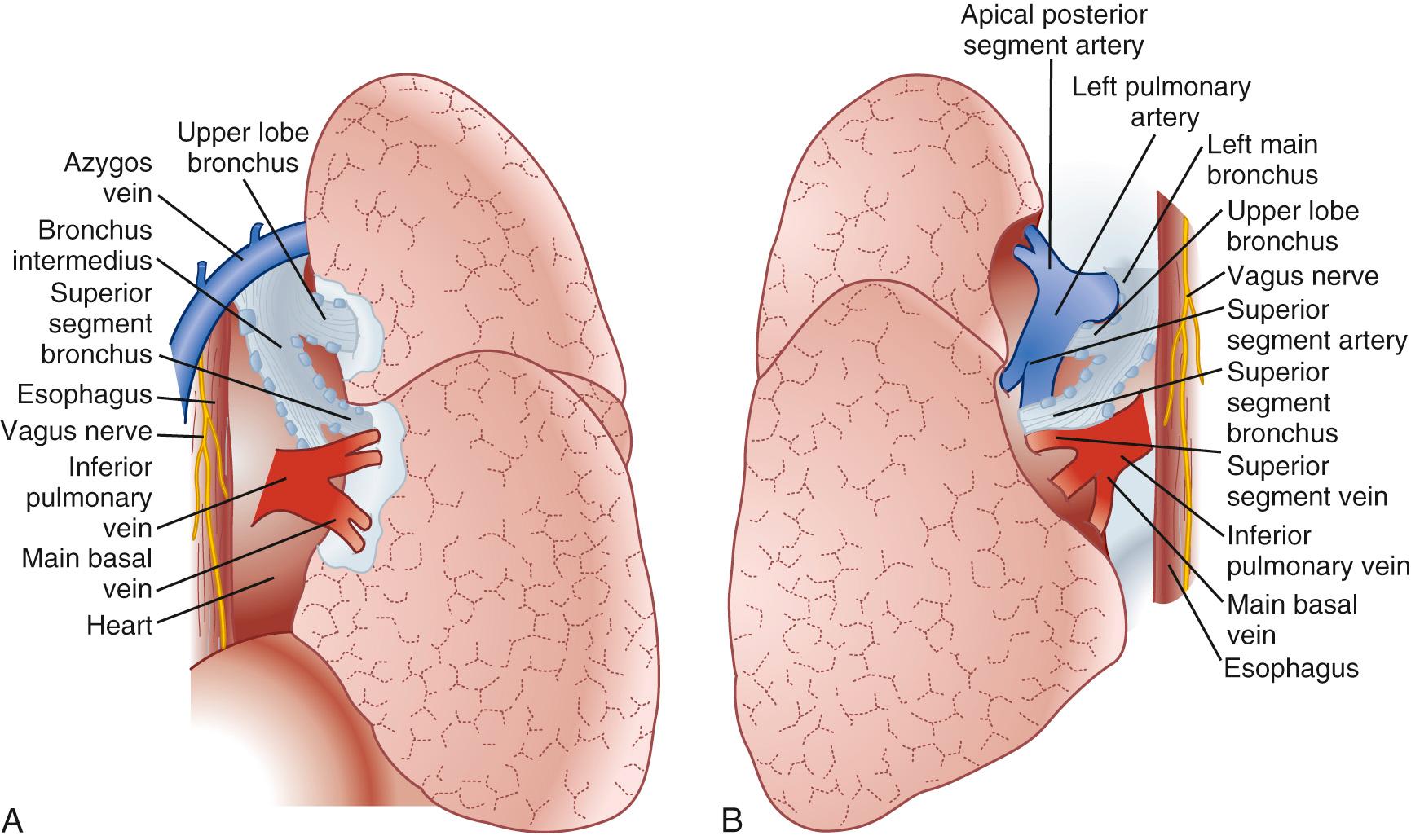
The hilar vascular structures (the main pulmonary artery and the superior and inferior pulmonary veins) are identified and dissected. The fissures between the lobes are often not completely open, so dissection is required to reach the interlobar structures. The incomplete fissures usually necessitate a combination of sharp and blunt dissection. Care must be taken to avoid violation of the tumor if an extension of the tumor from one lobe to another is seen. The interlobar views of right and left lungs are shown in Figure 17-2 .
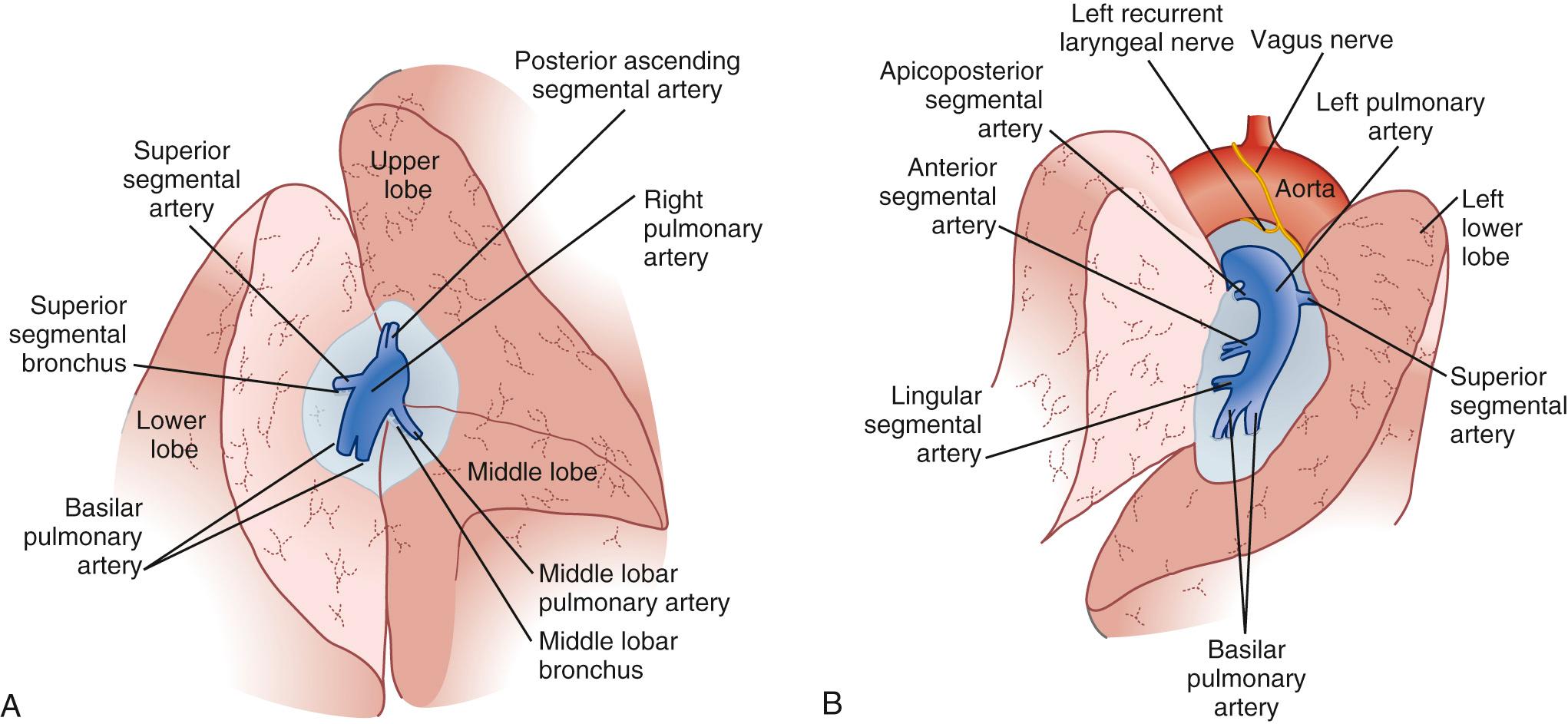
Once the interlobar pulmonary artery is identified, the segmental arteries are exposed to the appropriate plane by dissecting down onto the pulmonary arterial vascular plane. The fissures can be divided with electrocautery or with a mechanical stapler, depending on the amount of parenchymal tissue to be transected. For division of pulmonary arteries, some surgeons prefer transfixing ligatures (especially for larger vessels), and others apply simple nonabsorbable ligatures. The mechanical stapler can be also used to divide large vessels. It is preferable to isolate and tape the main pulmonary artery and pulmonary veins for control before starting vessel dissections in the following cases: (1) tumor invasion to the main trunk of the pulmonary artery, (2) tumor involving the roots of segmental arterial branches, or (3) significant inflammatory scarring or adhesions encountered around the pulmonary arteries. Using this technique, the main pulmonary artery and veins can be easily clamped for control if an arterial injury occurs.
The order of division of the vasculature is flexible; however, it is safe to divide pulmonary artery branches, then veins, followed by the bronchus, in most cases. Some prefer to divide veins first to avoid possible tumor cell dissemination into the blood circulation during the manipulation of the lung, but it has not been proven that this maneuver affects long-term outcome. The disadvantage of dividing the pulmonary veins before the artery branches is that the diseased lobe may become congested with retained blood, making the surgery difficult. It is often advantageous to first divide the structure whose absence allows better exposure of the remaining structures. For example, the bronchus can be divided first to obtain better exposure and dissection of the pulmonary artery branches if needed.
After obtaining the proposed bronchial margin by clearing peribronchial lymph nodes of the diseased lobe, bronchial closure is performed with a bronchial stapler. Excessive devascularization of the bronchial stump should be avoided to prevent bronchopleural fistula (BPF). Although closure can be performed by hand-suturing techniques, the stapling technique is faster and equally safe. Before firing the bronchial stapler, the anesthesiologist is asked to inflate the operative lung to confirm no impingement of the main bronchus or other remaining bronchi. Frozen-section pathologic examination of the bronchial margins should be obtained if there is any concern of tumor invasion. For poor-risk patients or those who received induction chemoradiotherapy, the bronchial stump should be covered with pericardial fat pad, pericardium, pleura, or intercostal muscle to minimize the chances of a postoperative BPF. In cases of sleeve lobectomy, cancer-free margins on both proximal and distal bronchial ends should be confirmed by frozen section. For the bronchial anastomosis, two traction stitches are placed on both bronchial ends. Interrupted 4-0 monofilament absorbable sutures are placed on the cartilaginous portion and a running monofilament absorbable suture on the membranous portion without any tension on the bronchial anastomosis.
Chest tubes are placed for evacuation of residual fluid and air to reexpand the residual lung. Another purpose of tube placement is for monitoring of postoperative bleeding. Although there are no standardized rules in terms of the tube size and number, we usually place an apical chest tube and an angled basilar chest tube above the diaphragm (28 Fr).
As anatomic lobectomy has become the standard form of curative resection for bronchogenic carcinoma, pneumonectomy has become less prevalent. Pneumonectomy is reserved for central lesions, traditionally, but even in patients with tumor invasion of the mainstem bronchus or bronchus intermedius, sleeve lobectomy is the procedure of choice, with acceptable morbidity, mortality, and long-term survival. After careful assessment and patient selection, pneumonectomy is used for patients with centrally located NSCLC that cannot be completely resected using bronchoplastic procedures.
Posterolateral thoracotomy via the fifth intercostal space is the standard approach because it provides excellent access to both the anterior and the posterior hila. Anterior thoracotomy or muscle-sparing (e.g., anterior serratus muscle or latissimus dorsi muscle) thoracotomy is another option of choice. On entering the pleural cavity, a careful assessment is performed to identify the extent of tumor. This includes bronchoscopic assessment at the time of surgery. The decision to perform pneumonectomy is usually made preoperatively on the basis of the tumor location and the cardiopulmonary reserve; however, occasionally, it is not possible to make a decision before the intraoperative assessment. A lesser resection such as sleeve lobectomy with or without pulmonary arterioplasty should always be considered as long as a complete en bloc tumor resection can be achieved.
Once the need for pneumonectomy is confirmed, the hilum is dissected to identify the main pulmonary artery and the superior and inferior pulmonary veins. After retracting the lung anterosuperiorly, the inferior pulmonary ligament is divided up to the level of the inferior pulmonary vein. The inferior pulmonary vein is exposed and isolated by dissecting surrounding connective tissues. On the right side, a plane between the main pulmonary artery and the superior pulmonary vein should be developed for dissection. On the left side, the superior pulmonary vein resides anterior to the left main bronchus, so a plane for dissection should be found between these structures. The division of the superior and inferior pulmonary veins can be performed by double ligation or stapling. When the tumor involves the pericardial reflection, the pericardium is opened for more proximal vessel isolation, and a vascular clamp is applied across the atrium for division of the pulmonary vein. After division of the vein, the stump is closed with a double-layer nonabsorbable suture.
When the tumor is in close proximity to the proximal pulmonary artery, and thus it is not possible to obtain a sufficient margin to apply a stapler, the pericardium should be opened to obtain additional length for division ( Fig. 17-3 ). On the right side, mobilization of the superior vena cava is often required to encircle the proximal right main pulmonary artery. On the left side, division of the ligamentum arteriosum produces additional length for division of the left main pulmonary artery proximally. During this maneuver, special attention should be paid to avoiding injury to the left recurrent laryngeal nerve, if the nerve is not involved by the tumor. Dissecting proximally after opening the pericardium at its reflection, one can divide the left pulmonary artery at its origin. It is important not to impinge on the right pulmonary artery when applying traction to staple the left main pulmonary artery.
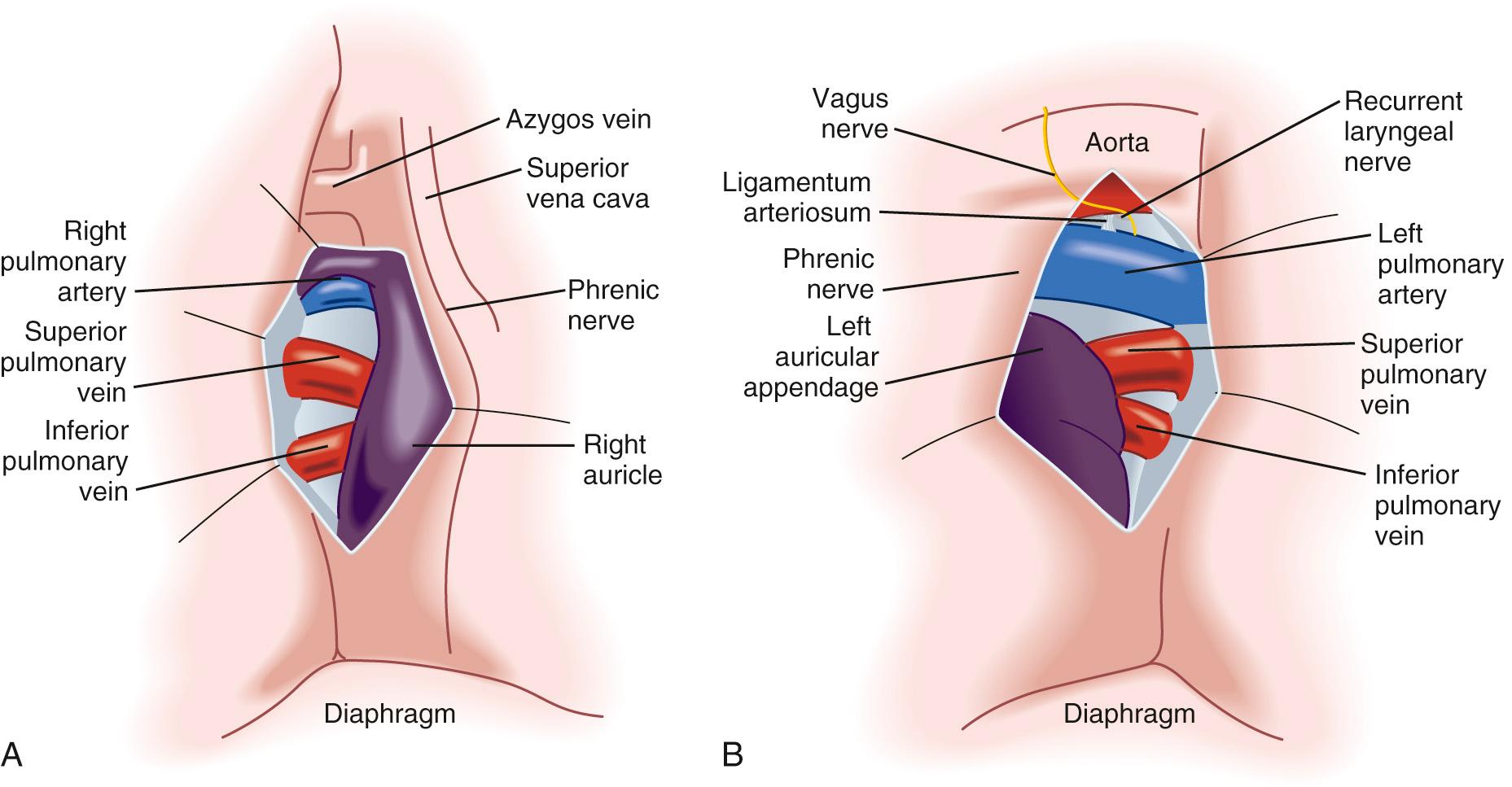
The division of the mainstem bronchus should be performed as proximally as possible (3 to 5 mm from the carina) to avoid creating an unnecessarily long bronchial stump. On the right side, the carina and the anticipated point of bronchial division is often visualized easily. The division of the left mainstem bronchus requires some traction on the bronchus, because the carina is poorly visualized from the left side. Peribronchial tissues and lymph nodes around the bronchus are cleared to better expose the bronchus, but an excessive devascularization should be avoided to preclude poor healing that could lead to postoperative BPF. In patients who received induction radiotherapy, the stump of the right main bronchus should be covered by a pericardial fat pad, mediastinal pleura, pericardium, intercostal muscle flap, or even omentum. Although it is generally desirable to protect the right main bronchial stump, it is not always necessary on the left side because the left main stump retracts into mediastinal tissues after division. Darling and colleagues reported the rates of BPF were approximately 13% on the right side and 5% on the left side, with 8% overall.
The goal of management of the postpneumonectomy space is to normalize (i.e., reposition) mediastinum to the midline. To accomplish this, some leave a small chest tube to evacuate a measured quantity of air immediately after surgery in the operating room, and then remove the tube, whereas others leave a chest tube with balanced pneumonectomy drainage systems (e.g., Pleur-evac [Teleflex Medical, Research Triangle Park, NC] balanced pneumonectomy drainage system) to avoid mediastinal shift while maintaining normal pressures. Alternatively, a chest tube can be left clamped and intermittently unclamped briefly to reposition the mediastinum. In any case, negative pressure to the chest tube must not be applied because it may cause a significant mediastinal shift to the operative side.
Sublobar resection was originally developed for the surgical management of infectious lung diseases such as tuberculosis and bronchiectasis, in which bilateral or multisegmental disease is frequently seen. For the treatment of NSCLC, this has generally been the option for patients with poor pulmonary function who may not tolerate anatomic lobectomy, because limited resections have demonstrated a higher local recurrence rate and worse long-term outcome than anatomic lobectomy. However, recent evidence suggests that sublobar resection, especially anatomic segmentectomy, may in fact be the surgical procedure of choice, not only for patients with poor cardiopulmonary reserve but also for those with early stage NSCLC at low risk. In general, anatomic segmentectomy is preferred over simple wedge resection to clear the lymphatics draining the tumor bed. Generous wedge resection with cancer-free margins may be acceptable for small, peripheral, “nonsolid” bronchioloalveolar carcinoma. Sampling or formal dissection of hilar and mediastinal lymph nodes with intraoperative frozen-section pathology should be performed to confirm any nodal disease. If proven positive for nodal disease intraoperatively, the surgical resection should be converted to anatomic lobectomy whenever possible.
Because the landmark of a diseased segment used to guide resection is its bronchus, identification of the bronchus of the diseased segment is a key step. The division of segmental structures tends to begin with the segmental arterial branch, because this often allows good exposure of the segmental bronchus, which runs along with the segmental artery. The segmental vein is best divided last, after identification of the intersegmental plane. Intersegmental veins, the venous drainage of adjacent segments, are usually preserved. The separation at the intersegmental lung parenchymal plane is performed with differential lung deflation and inflation. First, the segmental bronchus of the diseased segment is clamped in a deflated state. Then the lung is inflated, and the demarcation line can be identified because the diseased segment remains airless while other parts of the lung are expanded. Alternatively, the lung is expanded first, followed by clamping the bronchus of the diseased segment; then the lung is deflated to demarcate the diseased segment that remains expanded. Manual monofilament absorbable interrupted suturing (4-0 polydioxanone [PDS] or Maxon) is usually used for the bronchial closure. Stapling may be performed if sufficient length of the diseased segmental bronchus is available. In this case, care must be taken to avoid compromising adjacent segmental bronchi. Blunt or sharp dissection of the intersegmental plane is traditionally performed by scissors, a sponge on a stick, or the surgeon's fingers. Small bridging veins or bronchi are individually clipped or ligated for division. Stapling the intersegmental plane is also applicable and desirable, and this is achievable if the resection is extended into an adjacent segment to achieve an adequate margin from the tumor. Any air leaks from the dissecting plane are controlled by nonabsorbable suturing. Various types of segmentectomy are shown in Figure 17-4 .
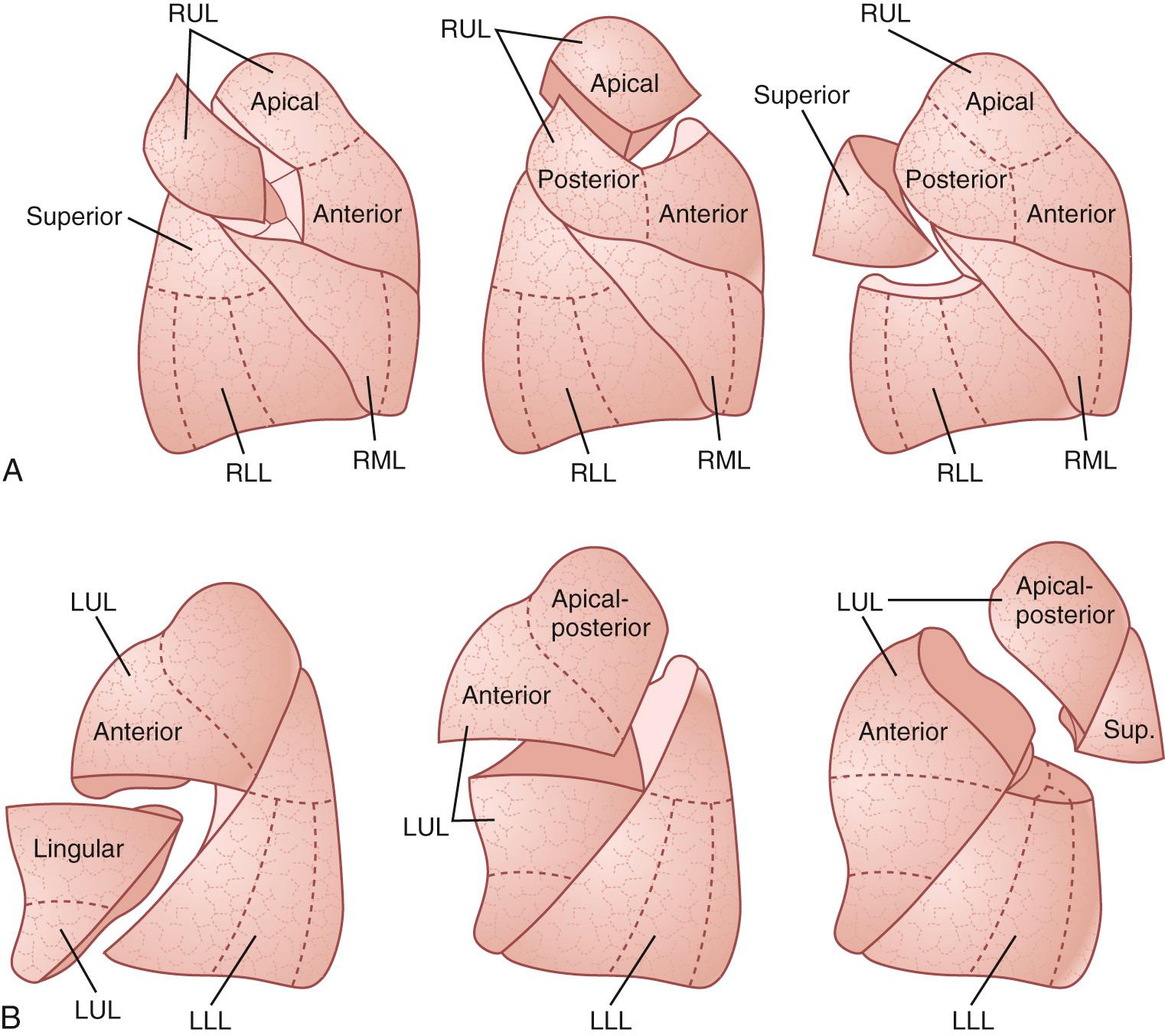
The use of wedge resection as a surgical procedure for primary lung cancer should be strictly limited to small, peripheral, early-stage NSCLC. Although wedge resection is often accomplished by VATS, it is often difficult to assess the interlobar lymph nodes. Whenever there is any doubt about the resection margins, the procedure should be converted to anatomic segmentectomy.
Recent advances in mediastinal staging with computed tomography (CT), positron emission tomography (PET), and endobronchial ultrasound–guided fine-needle aspiration (EBUS-FNA) have improved diagnostic accuracy. However, there is no doubt that intraoperative mediastinal lymph node staging remains the gold standard, and it is an integral part of the surgical treatment of lung cancer to determine accurate nodal (N) status, which is a significant outcome predictor. Generally, lymph node sampling indicates the removal of macroscopically abnormal lymph nodes. When biopsies are performed from all lymph node stations, it is said to be systematic sampling . If systematic removal of all the mediastinal tissue containing lymph nodes within anatomic landmarks is performed, it is referred to as complete lymph node dissection . Bilateral mediastinal and cervical lymph node clearance is referred to as extended lymph node dissection . It has been a subject of controversy as to whether complete lymph node dissection is superior to systematic sampling in diagnostic accuracy and long-term survival. These issues are discussed later. The classification and graphic representation of lymph node levels for lung cancer staging by the American Joint Committee on Cancer (AJCC) and the Union for International Cancer Control (UICC) are shown in Figure 17-5 .
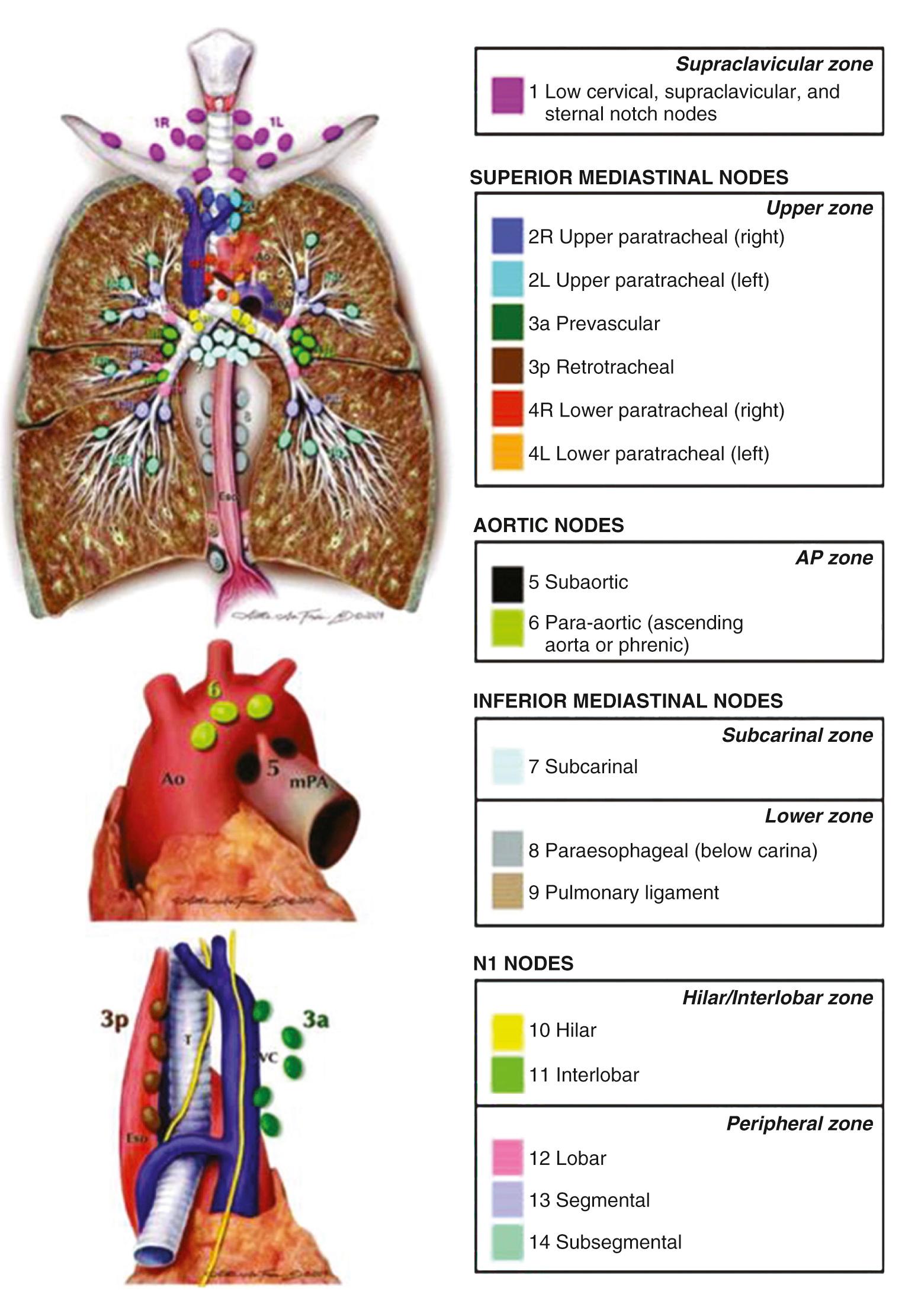
Mediastinal lymph node dissection (MLND) is almost always accompanied by lung resection for lung cancer, so the procedure is most frequently performed via a posterolateral thoracotomy. It can also be achieved via median sternotomy, anterior thoracotomy, or, more recently, VATS incisions. Although the surgical procedure and extent of MLND may vary from surgeon to surgeon, dissection of stations 2R, 4R, 7, 8, 9, and 10R for the right side and stations 5, 6, 7, 8, 9, and 10L on the left side is generally accepted. On the right side, the superior mediastinum bordered by the superior vena cava anteriorly, the trachea posteriorly, the innominate artery superiorly, and the azygos vein inferiorly, is dissected for lymphadenectomy. After incision of the mediastinal pleura, the mediastinal fat pad is dissected from the posterior aspect of the superior vena cava and the anterolateral surface of the trachea. One or two small draining veins are frequently seen from the mediastinal fat pad into the superior vena cava, and they are ligated or simply clipped. Right station 2 (2R) nodes are located between the cephalic border of the aortic arch and the cephalic border of the right innominate artery. Right station 4 (4R) nodes are found between the cephalic border of the aortic arch and the origin of the right upper lobe bronchus. Lymph nodes at station 3 posterior (3p) are dissected between the esophagus and the membranous portion of the trachea, and at station 3 anterior (3a) are taken anterior to the superior vena cava (anterior to the right phrenic nerve) where necessary. Right station 10 (10R) nodes are dissected along the anterior border of the right bronchus distal to the pleural reflection.
To expose the subcarinal lymph nodes (7), the lung is retracted anteriorly. After incision of the mediastinal pleura along with the anterior border of the esophagus, the subcarinal fat pad is dissected from the medial border of the right main bronchus laterally, the anterior aspect of the esophagus posteriorly, and the pericardium anteriorly. The attachments between the main bronchus and the fatty tissues containing subcarinal nodes are freed. The bronchial arterial branches running into the fat tissues are clipped before division to avoid unnecessary bleeding. The inferior pulmonary ligament nodes (9) are easy to dissect, and the paraesophageal nodes (8) are taken if they are present. On the left side, aortopulmonary (5 and 6) and subcarinal (7) nodes are dissected. For the upper mediastinal node dissection, the mediastinal pleura is incised just above the left main pulmonary artery, all the way up to the cephalic border of the aortic arch, midway between the phrenic nerve and the vagus nerve. Para-aortic (6) nodes are dissected from the phrenic nerve posteriorly and the ligamentum arteriosum anteriorly, and subaortic (5) nodes are removed posterior to the ligamentum arteriosum. During dissection, small arteries or veins should be controlled by ligation or clipping to avoid any thermal injury of the phrenic, vagus, and recurrent laryngeal nerves by electrocautery. Subcarinal (7) nodes can be removed in the same way as on the right side.
Surgical resection is generally considered in patients with stage I or II NSCLC. Those with locally advanced stage IIIA or IIIB NSCLC are usually treated with chemotherapy and radiotherapy. However, stages IIIA and IIIB represent heterogeneous groups of patients, and select patients will benefit from surgical resection.
The decision regarding surgical intervention is based on several variables, including the extent of disease (both T and N factors), age, cardiopulmonary reserve, performance status, and comorbid risk factors. Induction or adjuvant (postsurgical) chemotherapy with or without radiotherapy is offered to surgical candidates with locally advanced NSCLC. Recently, adjuvant or neoadjuvant chemotherapy has been also offered to patients with early-stage resectable NSCLC in clinical trial settings, and the combined approach appears to prolong survival.
The UICC and the AJCC published the seventh edition of the TNM classification for lung cancer in 2009.
The recently revised TNM descriptors are shown in Table 17-1 . Specific surgical issues related to each stage (T, N, and M) are discussed here.
| T (Primary Tumor) | |
| TX | Primary tumor cannot be assessed, or tumor proven by the presence of malignant cells in sputum or bronchial washings but not visualized by imaging or bronchoscopy |
| T0 | No evidence of primary tumor |
| Tis | Carcinoma in situ |
| T1 | Tumor ≤ 3 cm in greatest dimension, surrounded by lung or pleura, without bronchoscopic evidence of invasion more proximal than the lobar bronchus (i.e., not in the main bronchus) * |
| T1a | Tumor ≤ 2 cm in greatest dimension |
| T1b | Tumor > 2 cm but ≤ 3 cm in greatest dimension |
| T2 | Tumor > 3 cm but ≤ 7 cm or tumor with any of the following features (T2 tumors with these features are classified T2a if ≤ 5 cm) |
| Involves main bronchus, ≥2 cm distal to the carina | |
| Invades visceral pleura | |
| Associated with atelectasis or obstructive pneumonitis that extends to the hilar region but does not involve the entire lung | |
| T2a | Tumor > 3 cm but ≤ 5 cm in greatest dimension |
| T2b | Tumor > 5 cm but ≤ 7 cm in greatest dimension |
| T3 | Tumor > 7 cm or one that directly invades any of the following: chest wall (including superior sulcus tumors), diaphragm, phrenic nerve, mediastinal pleura, parietal pericardium; or tumor in the main bronchus < 2 cm distal to the carina * but without involvement of the carina; or associated atelectasis or obstructive pneumonitis of the entire lung or separate tumor nodule(s) in the same lobe |
| T4 | Tumor of any size that invades any of the following: mediastinum, heart, great vessels, trachea, recurrent laryngeal nerve, esophagus, vertebral body, carina; separate tumor nodule(s) in a different ipsilateral lobe |
| N (Regional Lymph Nodes) | |
| NX | Regional lymph nodes cannot be assessed |
| N0 | No regional lymph node metastasis |
| N1 | Metastasis in ipsilateral peribronchial and/or ipsilateral hilar lymph nodes and intrapulmonary nodes, including involvement by direct extension |
| N2 | Metastasis in ipsilateral mediastinal and/or subcarinal lymph node(s) |
| N3 | Metastasis in contralateral mediastinal, contralateral hilar, ipsilateral or contralateral scalene, or supraclavicular lymph node(s) |
| M (Distant Metastasis) | |
| MX | Distant metastasis cannot be assessed |
| M0 | No distant metastasis |
| M1 | Distant metastasis |
| M1a | Separate tumor nodule(s) in a contralateral lobe; tumor with pleural nodules or malignant pleural (or pericardial) effusion † |
| M1b | Distant metastasis |
* The uncommon superficial spreading tumor of any size with its invasive component limited to the bronchial wall, which may extend proximally to the main bronchus, is also classified as T1.
† Most pleural (and pericardial) effusions with lung cancer are due to tumor. In a few patients, however, multiple cytopathologic examinations of pleural (pericardial) fluid are negative for tumor, and the fluid is nonbloody and is not an exudate. Where these elements and clinical judgment dictate that the effusion is not related to the tumor, the effusion should be excluded as a staging element and the patient should be classified as T1, T2, T3, or T4.
Become a Clinical Tree membership for Full access and enjoy Unlimited articles
If you are a member. Log in here